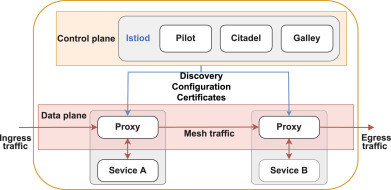- Published on
Demystifying Service Mesh with Istio Architecture, Benefits, and Practical Implementation
- Authors

- Name
- Adil ABBADI
Introduction
Managing microservices at scale presents unique challenges, from traffic management to robust security and observability. Service mesh architecture, with Istio as a leading implementation, offers powerful solutions for these challenges—empowering teams to gain deep control and insights without invasive code changes. In this article, we unravel Istio's architecture, see why it matters, and walk through practical examples to get started.

- Understanding Service Mesh and Istio
- Deploying Istio in a Kubernetes Cluster
- Traffic Management with Istio
- Observability and Security with Istio
- Conclusion
- Start Your Service Mesh Journey
Understanding Service Mesh and Istio
A service mesh is a dedicated infrastructure layer designed to facilitate service-to-service communications in a microservices architecture. Istio, an open-source project, is perhaps the most widely adopted service mesh platform for Kubernetes.
- Data Plane: Istio uses lightweight Envoy sidecar proxies injected alongside each application pod, intercepting all network traffic.
- Control Plane: The Istio control plane (Istiod) configures the proxies, manages traffic routing, enforces policies, and collects telemetry.
The separation of concerns means developers can focus on core business logic, relying on Istio for advanced networking, security, and observability features.

Deploying Istio in a Kubernetes Cluster
Istio can be easily installed using its official CLI tool. Here’s how to add Istio to your Kubernetes environment:
# Download Istio and add istioctl to your PATH
curl -L https://istio.io/downloadIstio | sh -
cd istio-*
export PATH=$PWD/bin:$PATH
# Install Istio with the default profile
istioctl install --set profile=demo -y
# Enable automatic sidecar injection in the default namespace
kubectl label namespace default istio-injection=enabled
These steps set up Istio’s control plane and ensure new pods automatically receive an Envoy sidecar proxy, enabling service mesh features by default.

Traffic Management with Istio
Istio’s traffic management capabilities let you define sophisticated routing rules that control how requests flow between services. Here’s an example of a simple Istio VirtualService for canary deployments:
# Example VirtualService for canary deployment
apiVersion: networking.istio.io/v1beta1
kind: VirtualService
metadata:
name: reviews
spec:
hosts:
- reviews
http:
- route:
- destination:
host: reviews
subset: v1
weight: 80
- destination:
host: reviews
subset: v2
weight: 20
In this example, 80% of traffic is routed to version v1 of the service, and 20% to v2—a classic canary release pattern.
Observability and Security with Istio
Istio integrates seamlessly with observability tools like Prometheus, Grafana, and Jaeger to provide extensive metrics, tracing, and logging without requiring app code modification.
Here’s how to enable Istio metrics scraping with Prometheus:
# Deploy Prometheus with Istio configuration
kubectl apply -f https://raw.githubusercontent.com/istio/istio/release-1.20/samples/addons/prometheus.yaml
# Port-forward Prometheus for local access
kubectl -n istio-system port-forward svc/prometheus 9090:9090
Istio also simplifies zero-trust security by enabling mutual TLS between services. To enforce mutual TLS on all workloads in a namespace:
# Apply PeerAuthentication policy for strict mTLS
apiVersion: security.istio.io/v1beta1
kind: PeerAuthentication
metadata:
name: default
namespace: default
spec:
mtls:
mode: STRICT
This policy ensures all inter-service traffic within the namespace is encrypted and authenticated automatically.
Conclusion
Istio brings powerful, consistent controls to microservices environments, tackling critical concerns like traffic management, security, and observability with minimal developer overhead. Its sidecar architecture and Kubernetes-native integration make it a compelling choice for enterprises navigating the complexities of cloud-native infrastructure.
Start Your Service Mesh Journey
Ready to transform your microservices platform? Try deploying Istio in a test Kubernetes cluster, and explore its features hands-on. The future of service networking is here—embrace it with Istio!
